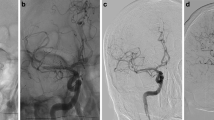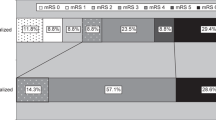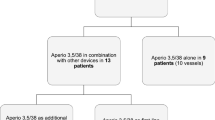Abstract
Background
Mechanical thrombectomy (MT) is a safe and efficient treatment for acute ischemic stroke in patients with proximal anterior occlusion and large penumbra. We evaluated the technical and clinical success of MT in relation to the location of the occlusion (internal carotid artery, M1 and M2 segments of the middle cerebral artery).
Methods
We prospectively reviewed 130 patients of whom 105 met the inclusion criteria. Baseline clinical, procedural and imaging variables, technical outcome (TICI, thrombolysis in cerebral infarction), 24 h imaging outcome and three-month clinical outcome (mRS, modified Rankin Scale) were recorded. Differences between the groups were studied with statistical tests according to the type of the variable.
Results
There were 37, 46 and 22 patients in the internal carotid artery (ICA), M1 and M2 groups, respectively. TICI 2b or 3 was achieved in 92 cases (88 %) with a non-significant trend towards a better recanalization outcome in the ICA and M1 groups. Overall, 57 of the 105 patients (55 %) experienced favorable clinical outcome (mRS ≤ 2) with no significant differences between the groups. Excellent outcome (mRS ≤ 1) was seen in 40 patients (39 %) and there proportionally more patients with excellent outcome in the ICA and M1 groups (ICA: 44 %, M1: 41 %, M2: 23 % of patients, p = 0.22).
Conclusions
There were no statistically significant differences in the technical or clinical outcomes between the different sites of occlusion (ICA, M1 or M2). There was a non-significant trend towards achieving excellent clinical outcome (3-month mRS ≤ 1) more often and better recanalization results in the two more proximal locations.


Similar content being viewed by others
Abbreviations
- ASPECTS:
-
Alberta Stroke Program Early CT Score
- CBV:
-
Cerebral blood volume
- COED:
-
Cerebral oedema
- ICA:
-
Internal carotid artery
- IV:
-
Intravenous
- MCA:
-
Middle cerebral artery
- MT:
-
Mechanical thrombectomy
- MTT:
-
Mean transit time
- NIHSS:
-
National Institutes of Health Stroke Scale
- TICI:
-
Thrombolysis in cerebral infarction
References
Berkhemer OA, Fransen PS, Beumer D, et al. A randomized trial of intraarterial treatment for acute ischemic stroke. N Engl J Med. 2015;372:11–20.
Goyal M, Demchuk AM, Menon BK, et al. Randomized assessment of rapid endovascular treatment of ischemic stroke. N Engl J Med. 2015;372:1019–30.
Jovin TG, Chamorro A, Cobo E, et al. Thrombectomy within 8 hours after symptom onset in ischemic stroke. N Engl J Med. 2015;372:2296–306.
Saver JL, Goyal M, Bonafe A, et al. Stent-retriever thrombectomy after intravenous t-PA vs. t-PA alone in stroke. N Engl J Med. 2015;372:2285–95.
Campbell BC, Mitchell PJ, Kleinig TJ, et al. Endovascular therapy for ischemic stroke with perfusion-imaging selection. N Engl J Med. 2015;372:1009–18.
Ding D. Endovascular mechanical thrombectomy for acute ischemic stroke: a new standard of care. J Stroke. 2015;17:123–6.
Nogueira RG, Lutsep HL, Gupta R, et al. Trevo versus Merci retrievers for thrombectomy revascularisation of large vessel occlusions in acute ischaemic stroke (TREVO 2): a randomised trial. Lancet. 2012;380:1231–40.
Zaidat OO, Castonguay AC, Gupta R, et al. North American Solitaire Stent Retriever Acute Stroke Registry: post-marketing revascularization and clinical outcome results. J Neurointerv Surg. 2014;6:584–8.
Saqqur M, Uchino K, Demchuk AM, et al. Site of arterial occlusion identified by transcranial Doppler predicts the response to intravenous thrombolysis for stroke. Stroke. 2007;38:948–54.
Zangerle A, Kiechl S, Spiegel M, et al. Recanalization after thrombolysis in stroke patients: predictors and prognostic implications. Neurology. 2007;68:39–44.
del Zoppo GJ, Poeck K, Pessin MS, et al. Recombinant tissue plasminogen activator in acute thrombotic and embolic stroke. Ann Neurol. 1992;32:78–86.
Schwaiger BJ, Gersing AS, Zimmer C, et al. The Curved MCA: influence of vessel anatomy on recanalization results of mechanical thrombectomy after acute ischemic stroke. AJNR Am J Neuroradiol. 2015;36:971–6.
Deshaies EM, Singla A, Villwock MR, et al. Early experience with stent retrievers and comparison with previous-generation mechanical thrombectomy devices for acute ischemic stroke. J Neurosurg. 2014;121:12–7.
Saver JL, Jahan R, Levy EI, et al. Solitaire flow restoration device versus the Merci Retriever in patients with acute ischaemic stroke (SWIFT): a randomised, parallel-group, non-inferiority trial. Lancet. 2012;380:1241–9.
Broussalis E, Trinka E, Hitzl W, et al. Comparison of stent-retriever devices versus the Merci retriever for endovascular treatment of acute stroke. AJNR Am J Neuroradiol. 2013;34:366–72.
Toni D, Lorenzano S, Puca E, et al. The SITS-MOST registry. Neurol Sci. 2006;27(Suppl 3):S260–2.
Sillanpaa N, Saarinen JT, Rusanen H, et al. CT perfusion ASPECTS in the evaluation of acute ischemic stroke: thrombolytic therapy perspective. Cerebrovasc Dis Extra. 2011;1:6–16.
Saarinen JT, Rusanen H, Sillanpaa N. Collateral score complements clot location in predicting the outcome of intravenous thrombolysis. AJNR Am J Neuroradiol. 2014;35:1892–6.
Saarinen JT, Sillanpaa N, Rusanen H, et al. The mid-M1 segment of the middle cerebral artery is a cutoff clot location for good outcome in intravenous thrombolysis. Eur J Neurol. 2012;19:1121–7.
Acknowledgments
The authors would like to thank Jyrki Ollikainen, MD, for clinical insights in preparing the manuscript. This study was financially supported by the Competitive State Research Financing of the Expert Responsibility Area of Tampere University Hospital (Grant 9S061).
Author information
Authors and Affiliations
Corresponding author
Ethics declarations
Conflict of Interest
All authors declare that they have no conflicts of interest relevant to this manuscript.
Ethical Standards
All procedures performed were in accordance with the ethical standards of the institutional and/or national research committee and with the 1964 Helsinki declaration and its later amendments or comparable ethical standards. For this type of study formal consent is not required.
Rights and permissions
About this article
Cite this article
Protto, S., Sillanpää, N., Pienimäki, JP. et al. Stent Retriever Thrombectomy in Different Thrombus Locations of Anterior Cerebral Circulation. Cardiovasc Intervent Radiol 39, 988–993 (2016). https://doi.org/10.1007/s00270-016-1315-4
Received:
Accepted:
Published:
Issue Date:
DOI: https://doi.org/10.1007/s00270-016-1315-4




